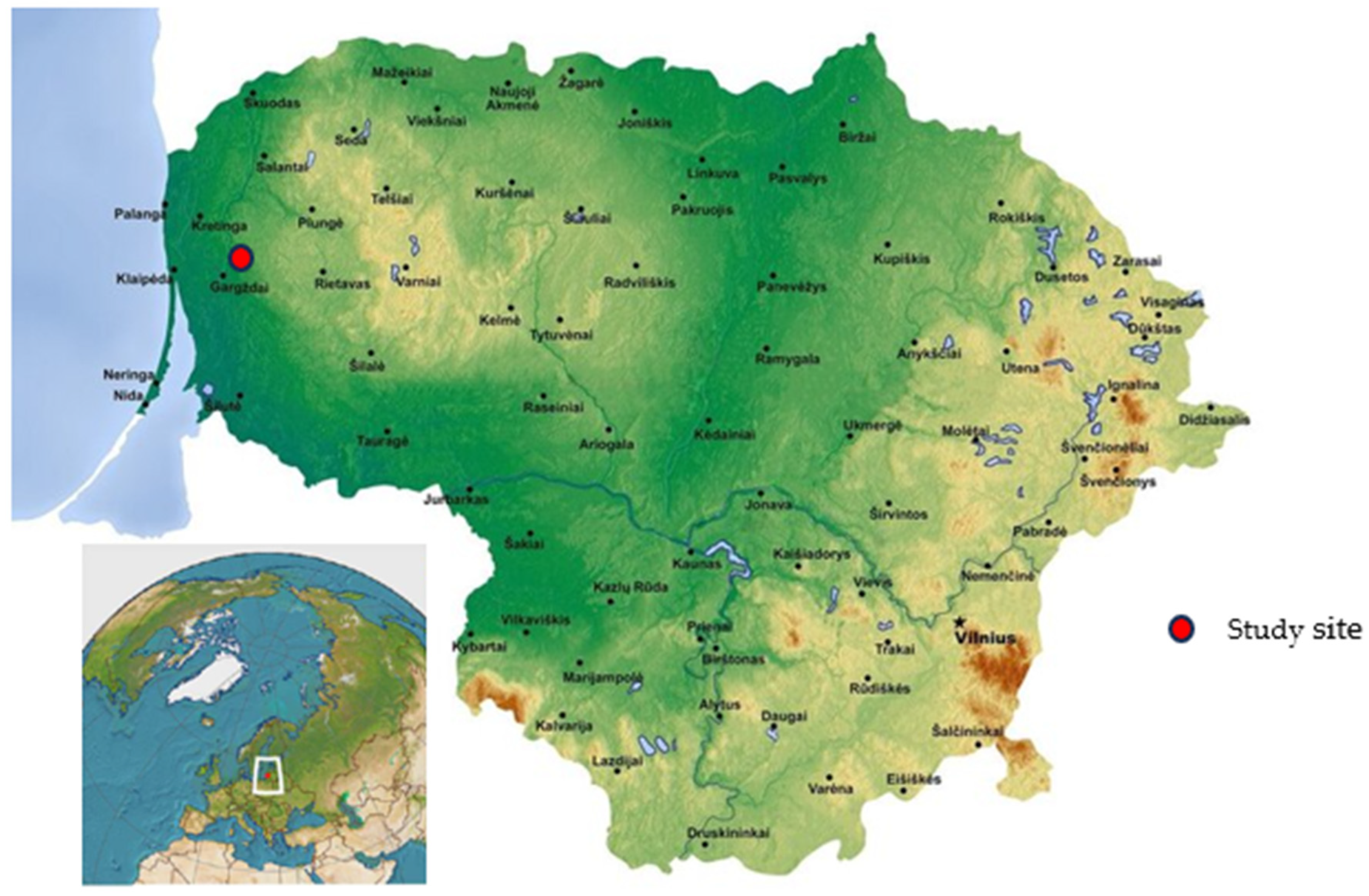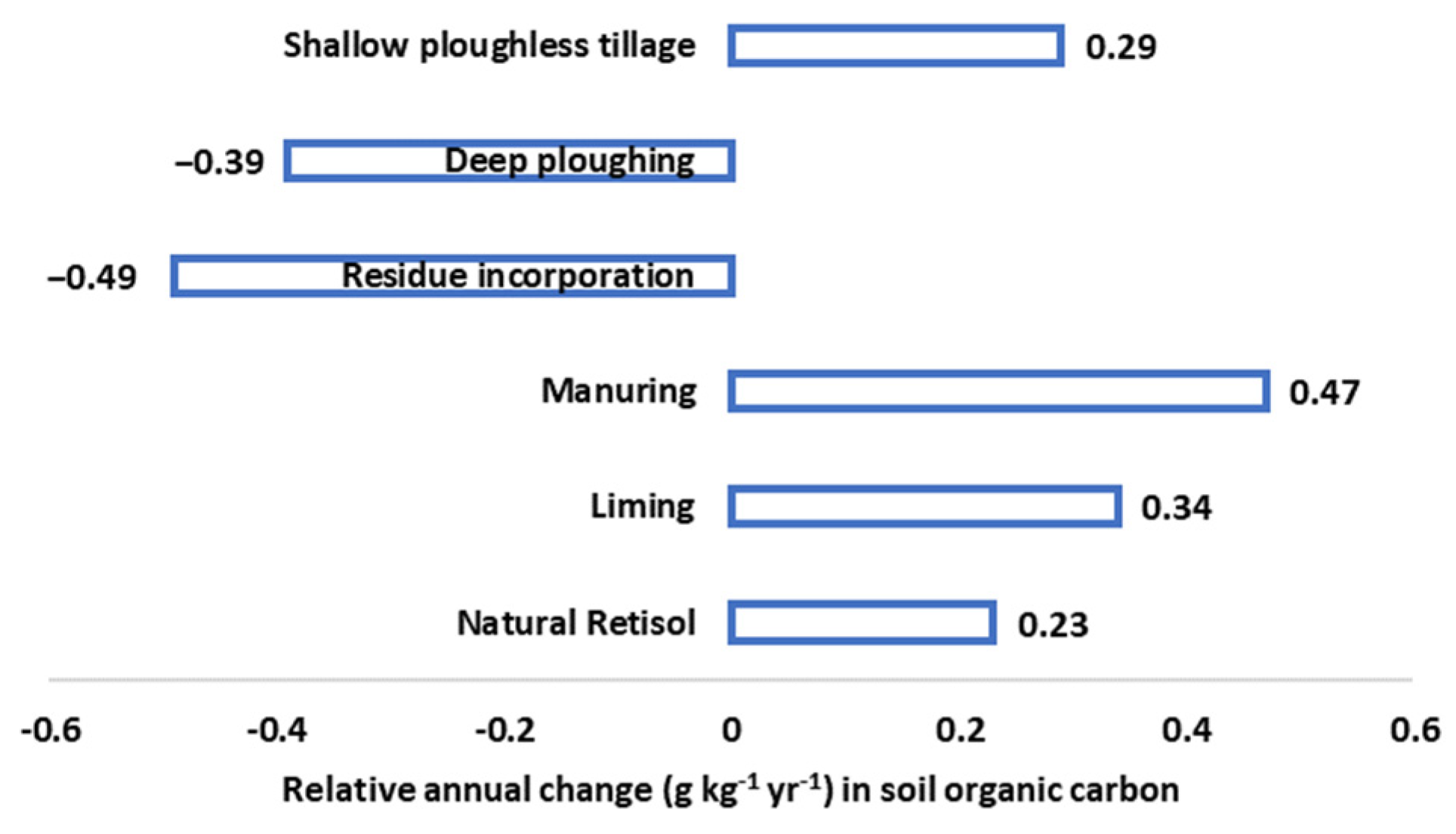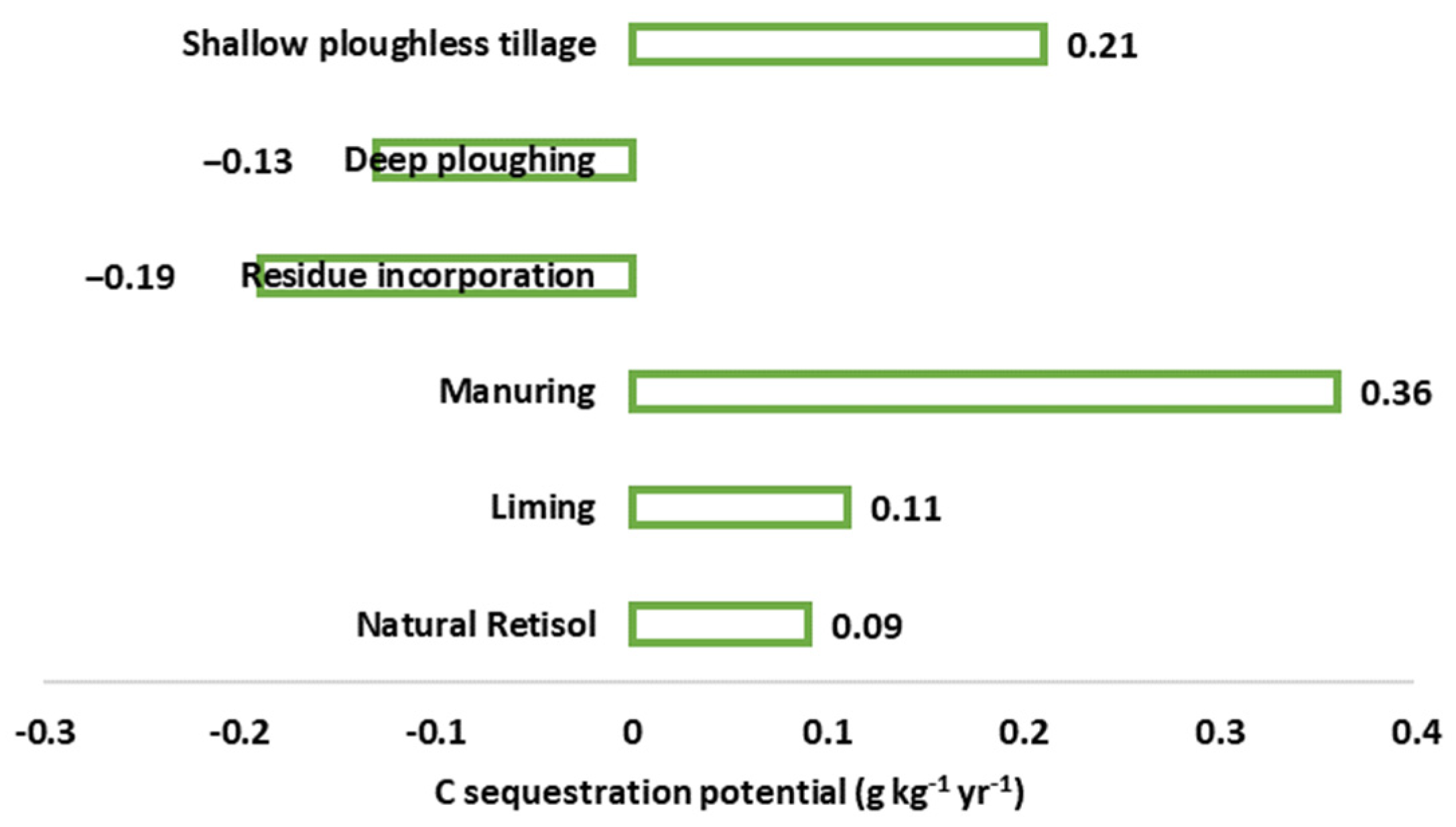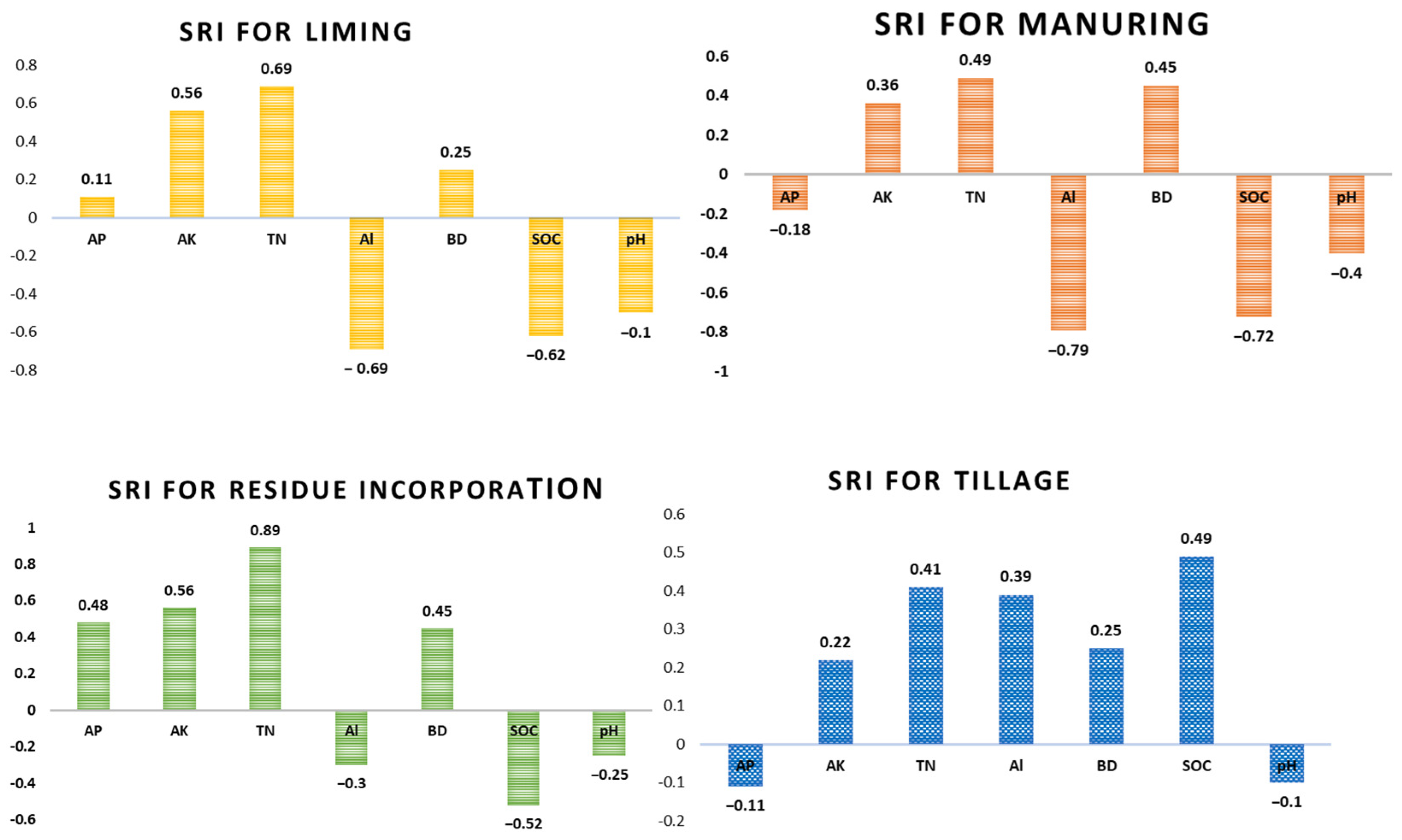Assessment of Management Practices to Prevent Soil Degradation Threats on Lithuanian Acid Soils
Abstract
1. Introduction
2. Materials and Methods
2.1. Study Area
2.2. Soil Sampling and Methods of Analyses
2.3. Calculation of Soil Degradation and Soil Resistances Indices
2.4. Statistical Analyses
3. Results and Discussion
3.1. Changes of Main Soil Properties under Different Soil Management Techniques
3.2. Influence of Different Soil Management Practices on SOC Content and Its Transformation Processes in the Topsoil
3.3. Soil Degradation and Resistance Indices of Different Soil Quality Parameters
4. Conclusions
Author Contributions
Funding
Institutional Review Board Statement
Informed Consent Statement
Data Availability Statement
Conflicts of Interest
References
- Cao, Y.; Li, X.; Qian, X.; Gu, H.; Li, J.; Chen, X.; Shen, G. Soil Health Assessment in the Yangtze River Delta of China: Method Development and Application in Orchards. Agric. Ecosyst. Environ. 2023, 341, 108190. [Google Scholar] [CrossRef]
- Ma, X.; Asano, M.; Tamura, K.; Zhao, R.; Nakatsuka, H.; Wuyunna; Wang, T. Physicochemical Properties and Micromorphology of Degraded Alpine Meadow Soils in the Eastern Qinghai-Tibet Plateau. Catena 2020, 194, 104649. [Google Scholar] [CrossRef]
- Orchard, C.M.; Lorentz, S.A.; Jewitt, G.P.W.; Chaplot, V.A.M. Spatial and Temporal Variations of Overland Flow during Rainfall Events and in Relation to Catchment Conditions. Hydrol. Process 2013, 27, 2325–2338. [Google Scholar] [CrossRef]
- Lal, R. Soil Carbon Sequestration Impacts on Global Climate Change and Food Security. Science 2004, 304, 1623–1627. [Google Scholar] [CrossRef] [PubMed]
- Baude, M.; Meyer, B.C.; Schindewolf, M. Land Use Change in an Agricultural Landscape Causing Degradation of Soil Based Ecosystem Services. Sci. Total Environ. 2019, 659, 1526–1536. [Google Scholar] [CrossRef] [PubMed]
- Yu, G.H.; Chen, C.M.; He, X.H.; Zhang, X.Z.; Li, L.N. Unexpected Bulk Density and Microstructures Response to Long-Term Pig Manure Application in a Ferralic Cambisol Soil: Implications for Rebuilding a Healthy Soil. Soil Tillage Res. 2020, 203, 104668. [Google Scholar] [CrossRef]
- Villamil, B.V.; Amiotti, N.M.; Peinemann, N. Soil Degradation Related to Overgrazing in the Semi-Arid Southern Caldenal Area of Argentina. Soil Sci. 2001, 166, 441–452. [Google Scholar] [CrossRef]
- Veerman, C.; Pinto Correia, T.; Bastioli, C.; Biro, B.; Bouma, J.; Cienciala, E.; Emmett, B.; Frison, E.A.; Grand, A.; Hristov, L.; et al. Caring for Soil Is Caring for Life—Ensure 75% of Soils Are Healthy by 2030 for Healthy Food, People, Nature and Climate; Publications Office of the European Union: Luxembourg, 2020. [Google Scholar]
- Lizarazo, C.I.; Tuulos, A.; Jokela, V.; Mäkelä, P.S.A. Sustainable Mixed Cropping Systems for the Boreal-Nemoral Region. Front. Sustain. Food Syst. 2020, 4, 103. [Google Scholar] [CrossRef]
- Naulleau, A.; Gary, C.; Prévot, L.; Hossard, L. Evaluating Strategies for Adaptation to Climate Change in Grapevine Production—A Systematic Review. Front. Plant Sci. 2021, 11, 607859. [Google Scholar] [CrossRef]
- Keating, B.A.; Carberry, P.S.; Bindraban, P.S.; Asseng, S.; Meinke, H.; Dixon, J. Eco-Efficient Agriculture: Concepts, Challenges, And Opportunities. Crop Sci. 2010, 50, S109–S119. [Google Scholar] [CrossRef]
- Kochian, L.V.; Piñeros, M.A.; Liu, J.; Magalhaes, J.V. Plant Adaptation to Acid Soils: The Molecular Basis for Crop Aluminum Resistance. Annu. Rev. Plant Biol. 2015, 66, 571–598. [Google Scholar] [CrossRef]
- Dai, Z.; Zhang, X.; Tang, C.; Muhammad, N.; Wu, J.; Brookes, P.C.; Xu, J. Potential Role of Biochars in Decreasing Soil Acidification—A Critical Review. Sci. Total Environ. 2017, 581–582, 601–611. [Google Scholar] [CrossRef]
- Sumner, M.E.; Noble, A.D. Soil Acidification: The World Story. In Handbook of Soil Acidity; CRC Press: Boca Raton, FL, USA, 2003. [Google Scholar]
- Holland, J.E.; Bennett, A.E.; Newton, A.C.; White, P.J.; McKenzie, B.M.; George, T.S.; Pakeman, R.J.; Bailey, J.S.; Fornara, D.A.; Hayes, R.C. Liming Impacts on Soils, Crops and Biodiversity in the UK: A Review. Sci. Total Environ. 2018, 610–611, 316–332. [Google Scholar] [CrossRef]
- Da Costa, C.H.M.; Crusciol, C.A.C. Long-Term Effects of Lime and Phosphogypsum Application on Tropical No-till Soybean-Oat-Sorghum Rotation and Soil Chemical Properties. Eur. J. Agron. 2016, 74, 119–132. [Google Scholar] [CrossRef]
- Saha, S.; Saha, B.; Seth, T.; Dasgupta, S.; Ray, M.; Pal, B.; Pati, S.; Mukhopadhyay, S.K.; Hazra, G. Micronutrients Availability in Soil–Plant System in Response to Long-Term Integrated Nutrient Management Under Rice–Wheat Cropping System. J. Soil Sci. Plant Nutr. 2019, 19, 712–724. [Google Scholar] [CrossRef]
- He, Y.T.; He, X.H.; Xu, M.G.; Zhang, W.J.; Yang, X.Y.; Huang, S.M. Long-Term Fertilization Increases Soil Organic Carbon and Alters Its Chemical Composition in Three Wheat-Maize Cropping Sites across Central and South China. Soil Tillage Res. 2018, 177, 79–87. [Google Scholar] [CrossRef]
- Chen, H.; Liang, Q.; Gong, Y.; Kuzyakov, Y.; Fan, M.; Plante, A.F. Reduced Tillage and Increased Residue Retention Increase Enzyme Activity and Carbon and Nitrogen Concentrations in Soil Particle Size Fractions in a Long-Term Field Experiment on Loess Plateau in China. Soil Tillage Res. 2019, 194, 104296. [Google Scholar] [CrossRef]
- Mustafa, A.; Minggang, X.; Ali Shah, S.A.; Abrar, M.M.; Nan, S.; Baoren, W.; Zejiang, C.; Saeed, Q.; Naveed, M.; Mehmood, K.; et al. Soil Aggregation and Soil Aggregate Stability Regulate Organic Carbon and Nitrogen Storage in a Red Soil of Southern China. J. Environ. Manag. 2020, 270, 110894. [Google Scholar] [CrossRef] [PubMed]
- Sisay Golla, A. Soil Acidity and Its Management Options in Ethiopia: A Review. Int. J. Sci. Res. Manag. 2019, 7, 1429–1440. [Google Scholar] [CrossRef]
- Agegnehu, G.; Amede, T.; Erkossa, T.; Yirga, C.; Henry, C.; Tyler, R.; Nosworthy, M.G.; Beyene, S.; Sileshi, G.W. Extent and Management of Acid Soils for Sustainable Crop Production System in the Tropical Agroecosystems: A Review. Acta Agric. Scand. B Soil Plant Sci. 2021, 71, 852–869. [Google Scholar] [CrossRef]
- Thorsøe, M.H.; Keesstra, S.; De Boever, M.; Buchová, K.; Bøe, F.; Castanheira, N.L.; Chenu, C.; Cornu, S.; Don, A.; Fohrafellner, J.; et al. Sustainable Soil Management: Soil Knowledge Use and Gaps in Europe. Eur. J. Soil Sci. 2023, 74, e13439. [Google Scholar] [CrossRef]
- Paz, A.M.; Castanheira, N.; Miloczki, J.; Carrasco, M.; Vicente, C.; Carranca, C.; Gonçalves, M.C.; Mihelič, R.; Visser, S.; Keesstra, S.; et al. Collected Knowledge on the Impacts of Agricultural Soil Management Practices in Europe. Eur. J. Soil Sci. 2024, 75, e13468. [Google Scholar] [CrossRef]
- Mäder, P.; Berner, A. Development of Reduced Tillage Systems in Organic Farming in Europe. Renew. Agric. Food Syst. 2012, 27, 7–11. [Google Scholar] [CrossRef]
- Saskia, V.; Saskia, K.; Órlaith, N.C.; Titia, M.; Edoardo, C.; Francois, S.J.; Claire, C.; Peter, K.; Jennie, B.; Niels, H.; et al. Roadmap for the European Joint Program SOIL: Towards Climate-Smart Sustainable Management of Agricultural Soils. In Proceedings of the TERRAenVISION 2019, Barcelona, Spain, 2–7 September 2019. [Google Scholar]
- ISO 10390:2005; Soil Quality—Determination of pH. International Standards Organization: Geneva, Switzerland, 2005.
- ISO 10694: 1995; Soil Quality—Determination of Organic and Total Carbon after Dry Combustion (Elementary Analysis). International Standards Organization: Geneva, Switzerland, 1995.
- ISO 14254:2018; Soil Quality—Determination of Exchangeable Acidity Using Barium Chloride Solution as Extractant. International Standards Organization: Geneva, Switzerland, 2018.
- Zhao, Q.; Liu, S.; Deng, L.; Dong, S.; Wang, C. Soil Degradation Associated with Water-Level Fluctuations in the Manwan Reservoir, Lancang River Basin. Catena 2014, 113, 226–235. [Google Scholar] [CrossRef]
- Orwin, K.H.; Wardle, D.A. New Indices for Quantifying the Resistance and Resilience of Soil Biota to Exogenous Disturbances. Soil Biol. Biochem. 2004, 36, 1907–1912. [Google Scholar] [CrossRef]
- Karstens, K.; Bodirsky, B.L.; Dietrich, J.P.; Dondini, M.; Heinke, J.; Kuhnert, M.; Müller, C.; Rolinski, S.; Smith, P.; Weindl, I.; et al. Management-Induced Changes in Soil Organic Carbon on Global Croplands. Biogeosciences 2022, 19, 5125–5149. [Google Scholar] [CrossRef]
- Barão, L.; Alaoui, A.; Ferreira, C.; Basch, G.; Schwilch, G.; Geissen, V.; Sukkel, W.; Lemesle, J.; Garcia-Orenes, F.; Morugán-Coronado, A.; et al. Assessment of Promising Agricultural Management Practices. Sci. Total Environ. 2019, 649, 610–619. [Google Scholar] [CrossRef]
- Alaoui, A.; Barão, L.; Ferreira, C.S.S.; Schwilch, G.; Basch, G.; Garcia-Orenes, F.; Morugan, A.; Mataix-Solera, J.; Kosmas, C.; Glavan, M.; et al. Visual Assessment of the Impact of Agricultural Management Practices on Soil Quality. Agron. J. 2020, 112, 2608–2623. [Google Scholar] [CrossRef]
- Wu, W.; Ma, B. Integrated Nutrient Management (INM) for Sustaining Crop Productivity and Reducing Environmental Impact: A Review. Sci. Total Environ. 2015, 512–513, 415–427. [Google Scholar] [CrossRef]
- Bossolani, J.W.; Crusciol, C.A.C.; Merloti, L.F.; Moretti, L.G.; Costa, N.R.; Tsai, S.M.; Kuramae, E.E. Long-Term Lime and Gypsum Amendment Increase Nitrogen Fixation and Decrease Nitrification and Denitrification Gene Abundances in the Rhizosphere and Soil in a Tropical No-till Intercropping System. Geoderma 2020, 375, 114476. [Google Scholar] [CrossRef]
- Getachew, A.; Temesgen, D.; Tolessa, D.; Ayalew, A.; Geremew, T.; Chelot, Y. Effect of Lime and Phosphorus Fertilizer on Acid Soil Properties and Barley Grain Yield at Bedi in Western Ethiopia. Afr. J. Agric. Res. 2017, 12, 3005–3012. [Google Scholar] [CrossRef]
- Eidukevichiene, M.J.; Ozheraitiene, D.J.; Tripolskaja, L.N.; Marcinkonis, S.I. The Effect of Long-Term Liming on the Chemical Properties of Lithuanian Soils. Eurasian Soil. Sci. 2001, 34, 999–1005. [Google Scholar]
- Eidukeviciene, M.; Volungevicius, J.; Marcinkonis, S.; Tripolskaja, L.; Karcauskiene, D.; Fullen, M.A.; Booth, C.A. Interdisciplinary Analysis of Soil Acidification Hazard and Its Legacy Effects in Lithuania. Nat. Hazards Earth Syst. Sci. 2010, 10, 1477–1485. [Google Scholar] [CrossRef][Green Version]
- Nikorych, V.A.; Szymański, W.; Polchyna, S.M.; Skiba, M. Genesis and Evolution of the Fragipan in Albeluvisols in the Precarpathians in Ukraine. Catena 2014, 119, 154–165. [Google Scholar] [CrossRef]
- Cai, A.; Zhang, W.; Xu, M.; Wang, B.; Wen, S.; Shah, S.A.A. Soil Fertility and Crop Yield after Manure Addition to Acidic Soils in South China. Nutr. Cycl. Agroecosyst. 2018, 111, 61–72. [Google Scholar] [CrossRef]
- Manna, M.C.; Swarup, A.; Wanjari, R.H.; Mishra, B.; Shahi, D.K. Long-Term Fertilization, Manure and Liming Effects on Soil Organic Matter and Crop Yields. Soil Tillage Res. 2007, 94, 397–409. [Google Scholar] [CrossRef]
- Jaskulska, I.; Jaskulski, D.; Kobierski, M. Effect of Liming on the Change of Some Agrochemical Soil Properties in a Long-Term Fertilization Experiment. Plant Soil Environ. 2014, 60, 146–150. [Google Scholar] [CrossRef]
- Repsiene, R.; Karcauskiene, D. Changes in the Chemical Properties of Acid Soil and Aggregate Stability in the Whole Profile under Long-Term Management History. Acta Agric. Scand. B Soil Plant Sci. 2016, 66, 671–676. [Google Scholar] [CrossRef]
- Benbi, D.K.; Brar, K.; Toor, A.S.; Singh, P. Total and Labile Pools of Soil Organic Carbon in Cultivated and Undisturbed Soils in Northern India. Geoderma 2015, 237, 149–158. [Google Scholar] [CrossRef]
- Bhattacharya, S.S.; Kim, K.H.; Das, S.; Uchimiya, M.; Jeon, B.H.; Kwon, E.; Szulejko, J.E. A Review on the Role of Organic Inputs in Maintaining the Soil Carbon Pool of the Terrestrial Ecosystem. J. Environ. Manag. 2016, 167, 214–227. [Google Scholar] [CrossRef]
- Da Silva Oliveira, D.M.; de Lima, R.P.; Barreto, M.S.C.; Verburg, E.E.J.; Mayrink, G.C.V. Soil Organic Matter and Nutrient Accumulation in Areas under Intensive Management and Swine Manure Application. J. Soils Sediments 2017, 17, 1–10. [Google Scholar] [CrossRef]
- Blanco-Moure, N.; Gracia, R.; Bielsa, A.C.; López, M.V. Soil Organic Matter Fractions as Affected by Tillage and Soil Texture under Semiarid Mediterranean Conditions. Soil Tillage Res. 2016, 155, 381–389. [Google Scholar] [CrossRef]
- Wang, Q.; Wang, Y.; Wang, Q.; Liu, J. Impacts of 9 Years of a New Conservational Agricultural Management on Soil Organic Carbon Fractions. Soil Tillage Res. 2014, 143, 1–6. [Google Scholar] [CrossRef]
- De Moraes Sá, J.C.; Potma Gonçalves, D.R.; Ferreira, L.A.; Mishra, U.; Inagaki, T.M.; Ferreira Furlan, F.J.; Moro, R.S.; Floriani, N.; Briedis, C.; de Oliveira Ferreira, A. Soil Carbon Fractions and Biological Activity Based Indices Can Be Used to Study the Impact of Land Management and Ecological Successions. Ecol. Indic. 2018, 84, 96–105. [Google Scholar] [CrossRef]
- Bronick, C.J.; Lal, R. Soil Structure and Management: A Review. Geoderma 2005, 124, 3–22. [Google Scholar] [CrossRef]
- Núez-Delgado, A.; López-Períago, E.; Díaz-Fierros-Viqueira, F. Pollution Attenuation by Soils Receiving Cattle Slurry after Passage of a Slurry-like Feed Solution. —Column Experiments. Bioresour. Technol. 2002, 84, 229–236. [Google Scholar] [CrossRef] [PubMed]
- Pousada-Ferradás, Y.; Seoane-Labandeira, S.; Mora-Gutierrez, A.; Núñez-Delgado, A. Risk of Water Pollution Due to Ash-Sludge Mixtures: Column Trials. Int. J. Environ. Sci. Technol. 2012, 9, 21–29. [Google Scholar] [CrossRef][Green Version]
- Dumale, W.A., Jr.; Miyazaki, T.; Hirai, K.; Nishimura, T. SOC Turnover and Lime-CO2 Evolution during Liming of an Acid Andisol and Ultisol. Open J. Soil Sci. 2011, 01, 49–53. [Google Scholar] [CrossRef]
- Koga, N.; Tsuji, H. Effects of Reduced Tillage, Crop Residue Management and Manure Application Practices on Crop Yields and Soil Carbon Sequestration on an Andisol in Northern Japan. Soil Sci. Plant Nutr. 2009, 55, 546–557. [Google Scholar] [CrossRef]
- Bispo, D.F.A.; Guimarães, D.V.; Marques, J.J.G.d.S.M.; Beniaich, A.; Acuña-Guzman, S.F.; Silva, M.L.N.; Curi, N. Soil Organic Carbon as Response to Reforestation Age and Land Use Changes: A Qualitative Approach to Ecosystem Services. Sustainability 2023, 15, 6863. [Google Scholar] [CrossRef]
- Chen, X.; Mao, A.; Zhang, Y.; Zhang, L.; Chang, J.; Gao, H.; Thompson, M.L. Carbon and Nitrogen Forms in Soil Organic Matter Influenced by Incorporated Wheat and Corn Residues. Soil Sci. Plant Nutr. 2017, 63, 377–387. [Google Scholar] [CrossRef]
- Lal, R. Soil Carbon Sequestration to Mitigate Climate Change. Geoderma 2004, 123, 1–22. [Google Scholar] [CrossRef]
- Bhattacharyya, R.; Prakash, V.; Kundu, S.; Pandey, S.C.; Srivastva, A.K.; Gupta, H.S. Effect of Fertilisation on Carbon Sequestration in Soybeanwheat Rotation under Two Contrasting Soils and Management Practices in the Indian Himalayas. Aust. J. Soil Res. 2009, 47, 592–601. [Google Scholar] [CrossRef]
- Ogunwole, J.O. Changes in an Alfisol under Long-Term Application of Manure and Inorganic Fertilizer. Soil Use Manag. 2005, 21, 260–261. [Google Scholar] [CrossRef]
- Sabeena, M.S.; Sridevi, G.; Jayanthi, D.; Balachandar, D.; Dheebakaran, G. Integrated Effect of Organic and Inorganic Manuring on Crop Yield and Soil Nutrient Balance in the On-Going Century-Old Permanent Manurial Experiment. Int. J. Plant Soil Sci. 2022, 34, 645–658. [Google Scholar] [CrossRef]
- Sharma, K.L.; Ramachandrappa, B.K.; Chandrika, D.S.; Sathish, A.; Dhanpal, G.N.; Rao, C.S.; Shankar, M.A.; Grace, J.K.; Sankar, G.R.M.; Chary, G.R.; et al. Effect of Organic Manure and Crop Residue Based Long-Term Nutrient Management Systems on Soil Quality Changes under Sole Finger Millet (Eleusine Coracana (L.) Gaertn.) and Groundnut (Arachis Hypogaea L.)—Finger Millet Rotation in Rainfed Alfisol. Commun. Soil Sci. Plant Anal. 2016, 47, 899–914. [Google Scholar] [CrossRef]
- Anandakumar, S.; Bakhoum, N.; Chinnadurai, C.; Malarkodi, M.; Arulmozhiselvan, K.; Karthikeyan, S.; Balachandar, D. Impact of Long-Term Nutrient Management on Sequestration and Dynamics of Soil Organic Carbon in a Semi-Arid Tropical Alfisol of India. Appl. Soil Ecol. 2022, 177, 104549. [Google Scholar] [CrossRef]
- Chivenge, P.; Vanlauwe, B.; Six, J. Does the Combined Application of Organic and Mineral Nutrient Sources Influence Maize Productivity? A Meta-Analysis. Plant Soil 2011, 342, 1–30. [Google Scholar] [CrossRef]
- Rui, W.; Zhang, W. Effect Size and Duration of Recommended Management Practices on Carbon Sequestration in Paddy Field in Yangtze Delta Plain of China: A Meta-Analysis. Agric. Ecosyst. Environ. 2010, 135, 199–205. [Google Scholar] [CrossRef]
- Fang, H.J.; Cheng, S.L.; Yu, G.R.; Yang, X.M.; Xu, M.J.; Wang, Y.S.; Li, L.S.; Dang, X.S.; Wang, L.; Li, Y.N. Nitrogen Deposition Impacts on the Amount and Stability of Soil Organic Matter in an Alpine Meadow Ecosystem Depend on the Form and Rate of Applied Nitrogen. Eur. J. Soil Sci. 2014, 65, 510–519. [Google Scholar] [CrossRef]
- Locatelli, J.L.; de Lima, R.P.; Santos, R.S.; Cherubin, M.R.; Creamer, R.E.; Cerri, C.E.P. Soil Strength and Structural Stability Are Mediated by Soil Organic Matter Composition in Agricultural Expansion Areas of the Brazilian Cerrado Biome. Agronomy 2023, 13, 71. [Google Scholar] [CrossRef]
- Wu, L.; Zheng, H.; Wang, X. Effects of Soil Amendments on Fractions and Stability of Soil Organic Matter in Saline-Alkaline Paddy. J. Environ. Manag. 2021, 294, 112993. [Google Scholar] [CrossRef] [PubMed]
- Iheshiulo, E.M.A.; Larney, F.J.; Hernandez-Ramirez, G.; St. Luce, M.; Chau, H.W.; Liu, K. Soil Organic Matter and Aggregate Stability Dynamics under Major No-till Crop Rotations on the Canadian Prairies. Geoderma 2024, 442, 116777. [Google Scholar] [CrossRef]
- De Clercq, T.; Heiling, M.; Dercon, G.; Resch, C.; Aigner, M.; Mayer, L.; Mao, Y.; Elsen, A.; Steier, P.; Leifeld, J.; et al. Predicting Soil Organic Matter Stability in Agricultural Fields through Carbon and Nitrogen Stable Isotopes. Soil Biol. Biochem. 2015, 88, 29–38. [Google Scholar] [CrossRef]
- Trabaquini, K.; Formaggio, A.R.; Galvão, L.S. Changes in Physical Properties of Soils with Land Use Time in the Brazilian Savanna Environment. Land Degrad. Dev. 2015, 26, 397–408. [Google Scholar] [CrossRef]
- Sione, S.M.J.; Wilson, M.G.; Lado, M.; González, A.P. Evaluation of Soil Degradation Produced by Rice Crop Systems in a Vertisol, Using a Soil Quality Index. Catena 2017, 150, 79–86. [Google Scholar] [CrossRef]
- Kartini, N.L.; Saifulloh, M.; Trigunasih, N.M.; Narka, I.W. Assessment of Soil Degradation Based on Soil Properties and Spatial Analysis in Dryland Farming. J. Ecol. Eng. 2023, 24, 368–375. [Google Scholar] [CrossRef]
- Dlamini, P.; Chivenge, P.; Manson, A.; Chaplot, V. Land Degradation Impact on Soil Organic Carbon and Nitrogen Stocks of Sub-Tropical Humid Grasslands in South Africa. Geoderma 2014, 235–236, 372–381. [Google Scholar] [CrossRef]
- Dong, S.K.; Wen, L.; Li, Y.Y.; Wang, X.X.; Zhu, L.; Li, X.Y. Soil-Quality Effects of Grassland Degradation and Restoration on the Qinghai-Tibetan Plateau. Soil Sci. Soc. Am. J. 2012, 76, 2256–2264. [Google Scholar] [CrossRef]
- Wu, R.; Tiessen, H. Effect of Land Use on Soil Degradation in Alpine Grassland Soil, China. Soil Sci. Soc. Am. J. 2002, 66, 1648–1655. [Google Scholar] [CrossRef]
- Nascimento, C.M.; de Sousa Mendes, W.; Quiñonez Silvero, N.E.; Poppiel, R.R.; Sayão, V.M.; Dotto, A.C.; Valadares dos Santos, N.; Accorsi Amorim, M.T.; Demattê, J.A.M. Soil Degradation Index Developed by Multitemporal Remote Sensing Images, Climate Variables, Terrain and Soil Atributes. J. Environ. Manag. 2021, 277, 111316. [Google Scholar] [CrossRef] [PubMed]
- Gebremedhin, H.; Gebresamual, G.; Abadi, N.; Hailemariam, M.; Teka, K.; Mesfin, S. Conversion of Communal Grazing Land into Arable Land and Its Impacts on Soil Properties and Vegetation Cover. Arid Land Res. Manag. 2018, 32, 236–252. [Google Scholar] [CrossRef]
- Sharma, V.; Hussain, S.; Sharma, K.R.; Arya, V.M. Labile Carbon Pools and Soil Organic Carbon Stocks in the Foothill Himalayas under Different Land Use Systems. Geoderma 2014, 232–234, 81–87. [Google Scholar] [CrossRef]
- Zahedifar, M. Assessing Alteration of Soil Quality, Degradation, and Resistance Indices under Different Land Uses through Network and Factor Analysis. Catena 2023, 222, 106807. [Google Scholar] [CrossRef]
- Smith, C.; Jayathunga, S.; Gregorini, P.; Pereira, F.C.; McWilliam, W. Using Soil Sustainability and Resilience Concepts to Support Future Land Management Practice: A Case Study of Mt Grand Station, Hāwea, New Zealand. Sustainability 2022, 14, 1808. [Google Scholar] [CrossRef]
- Raiesi, F.; Beheshti, A. Evaluating Forest Soil Quality after Deforestation and Loss of Ecosystem Services Using Network Analysis and Factor Analysis Techniques. Catena 2022, 208, 105778. [Google Scholar] [CrossRef]








Disclaimer/Publisher’s Note: The statements, opinions and data contained in all publications are solely those of the individual author(s) and contributor(s) and not of MDPI and/or the editor(s). MDPI and/or the editor(s) disclaim responsibility for any injury to people or property resulting from any ideas, methods, instructions or products referred to in the content. |
© 2024 by the authors. Licensee MDPI, Basel, Switzerland. This article is an open access article distributed under the terms and conditions of the Creative Commons Attribution (CC BY) license (https://creativecommons.org/licenses/by/4.0/).
Share and Cite
Mockeviciene, I.; Karcauskiene, D.; Vilkiene, M.; Repsiene, R.; Feiza, V.; Budryte, O. Assessment of Management Practices to Prevent Soil Degradation Threats on Lithuanian Acid Soils. Sustainability 2024, 16, 5869. https://doi.org/10.3390/su16145869
Mockeviciene I, Karcauskiene D, Vilkiene M, Repsiene R, Feiza V, Budryte O. Assessment of Management Practices to Prevent Soil Degradation Threats on Lithuanian Acid Soils. Sustainability. 2024; 16(14):5869. https://doi.org/10.3390/su16145869
Chicago/Turabian StyleMockeviciene, Ieva, Danute Karcauskiene, Monika Vilkiene, Regina Repsiene, Virginijus Feiza, and Otilija Budryte. 2024. "Assessment of Management Practices to Prevent Soil Degradation Threats on Lithuanian Acid Soils" Sustainability 16, no. 14: 5869. https://doi.org/10.3390/su16145869
APA StyleMockeviciene, I., Karcauskiene, D., Vilkiene, M., Repsiene, R., Feiza, V., & Budryte, O. (2024). Assessment of Management Practices to Prevent Soil Degradation Threats on Lithuanian Acid Soils. Sustainability, 16(14), 5869. https://doi.org/10.3390/su16145869





